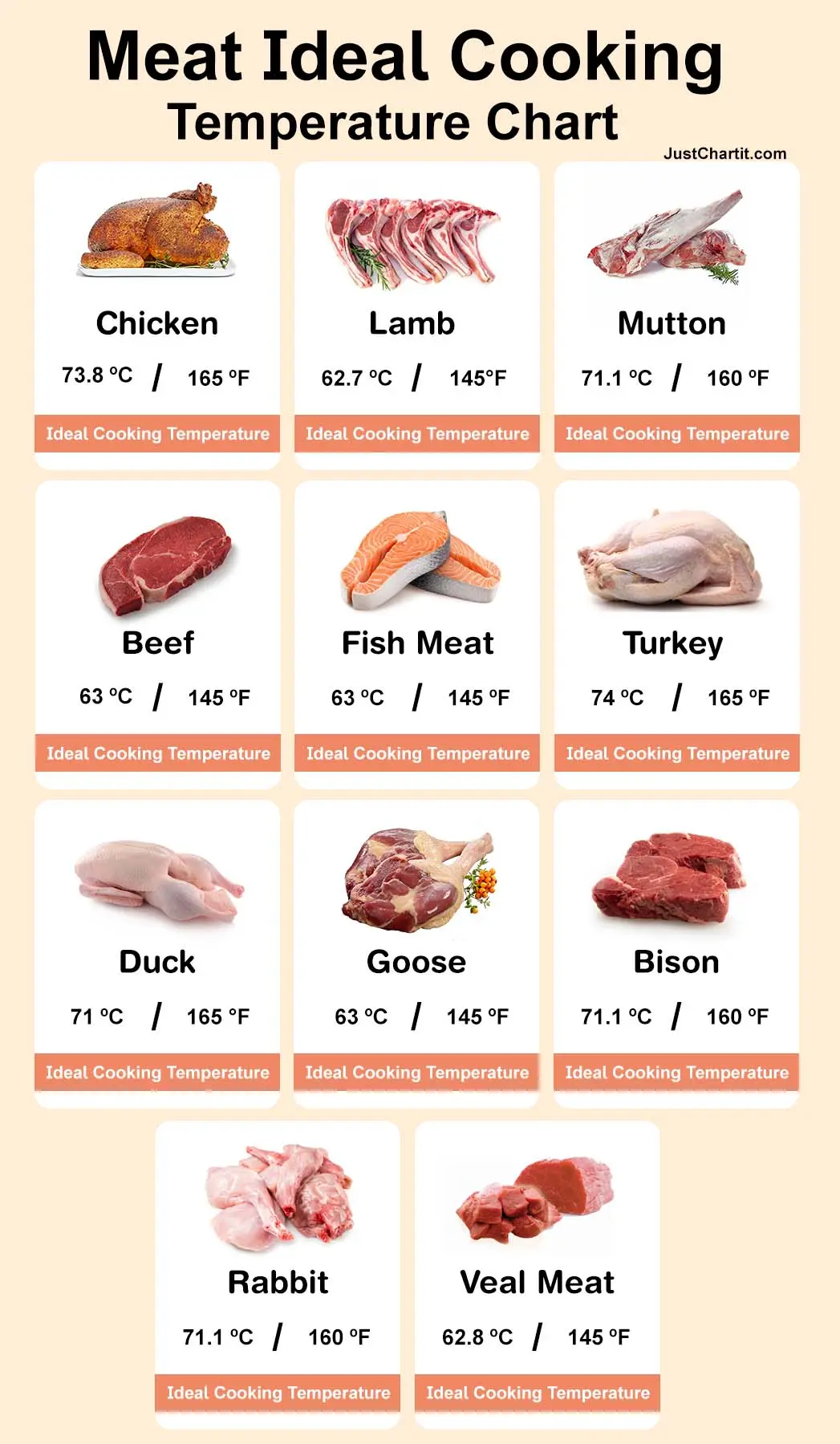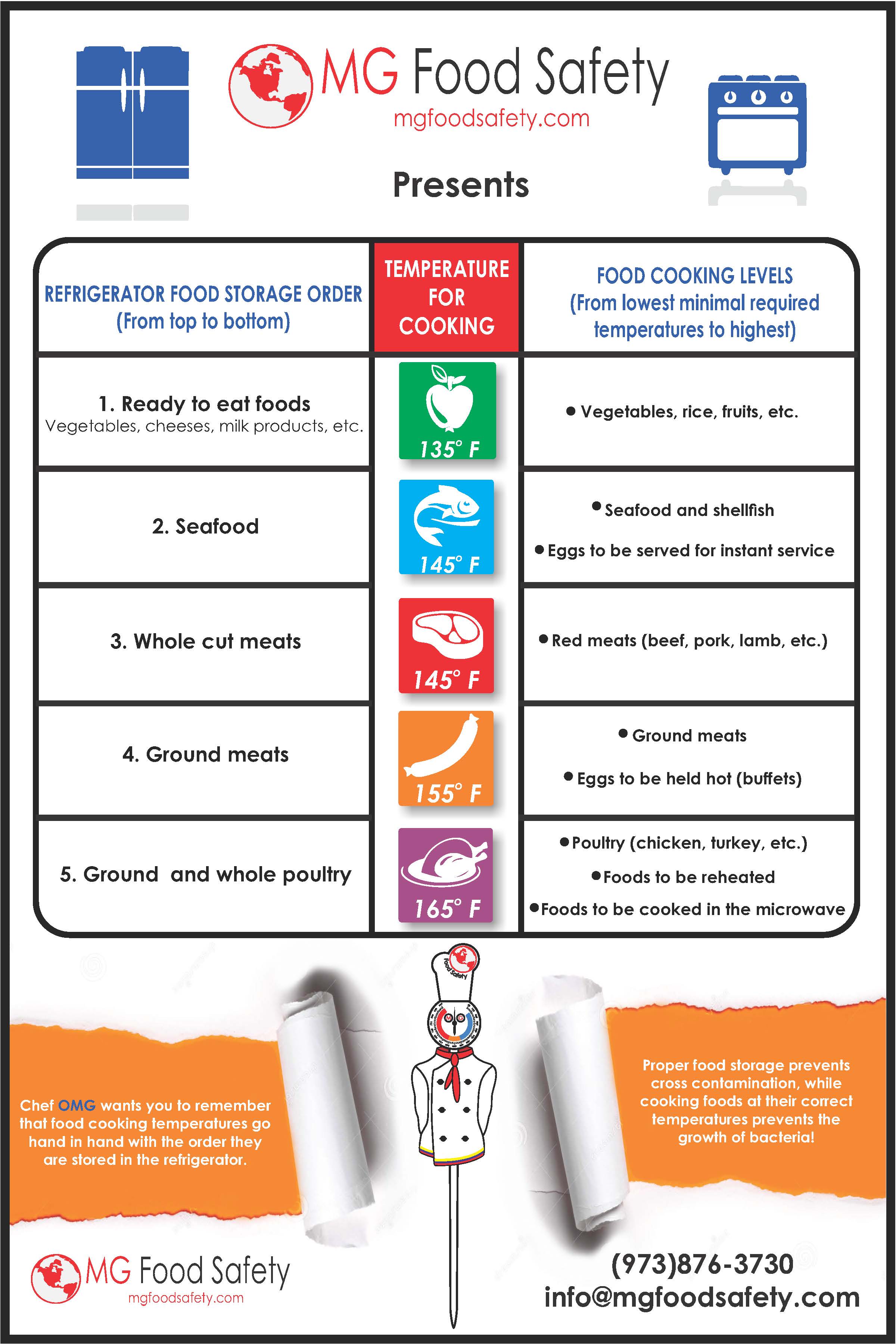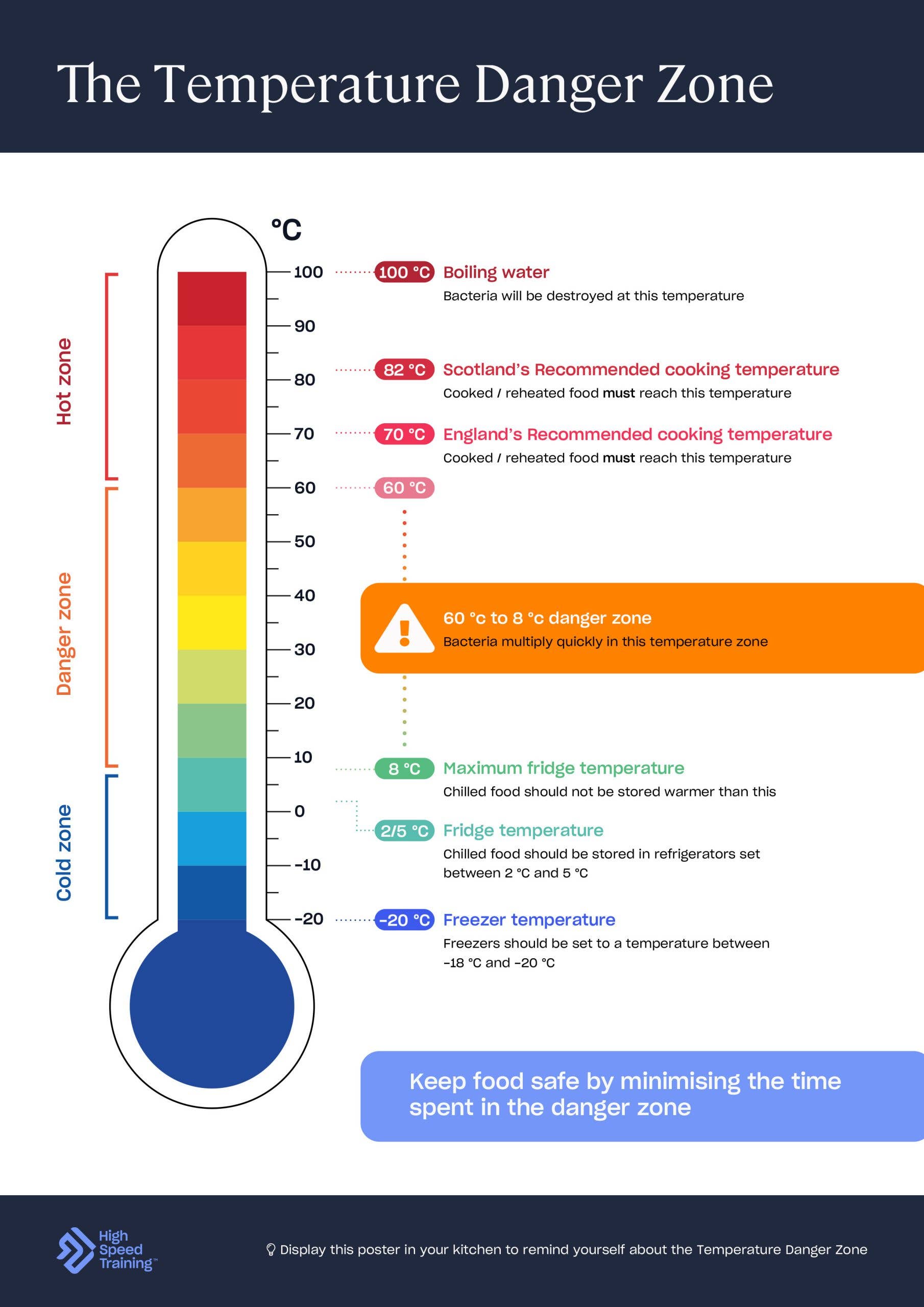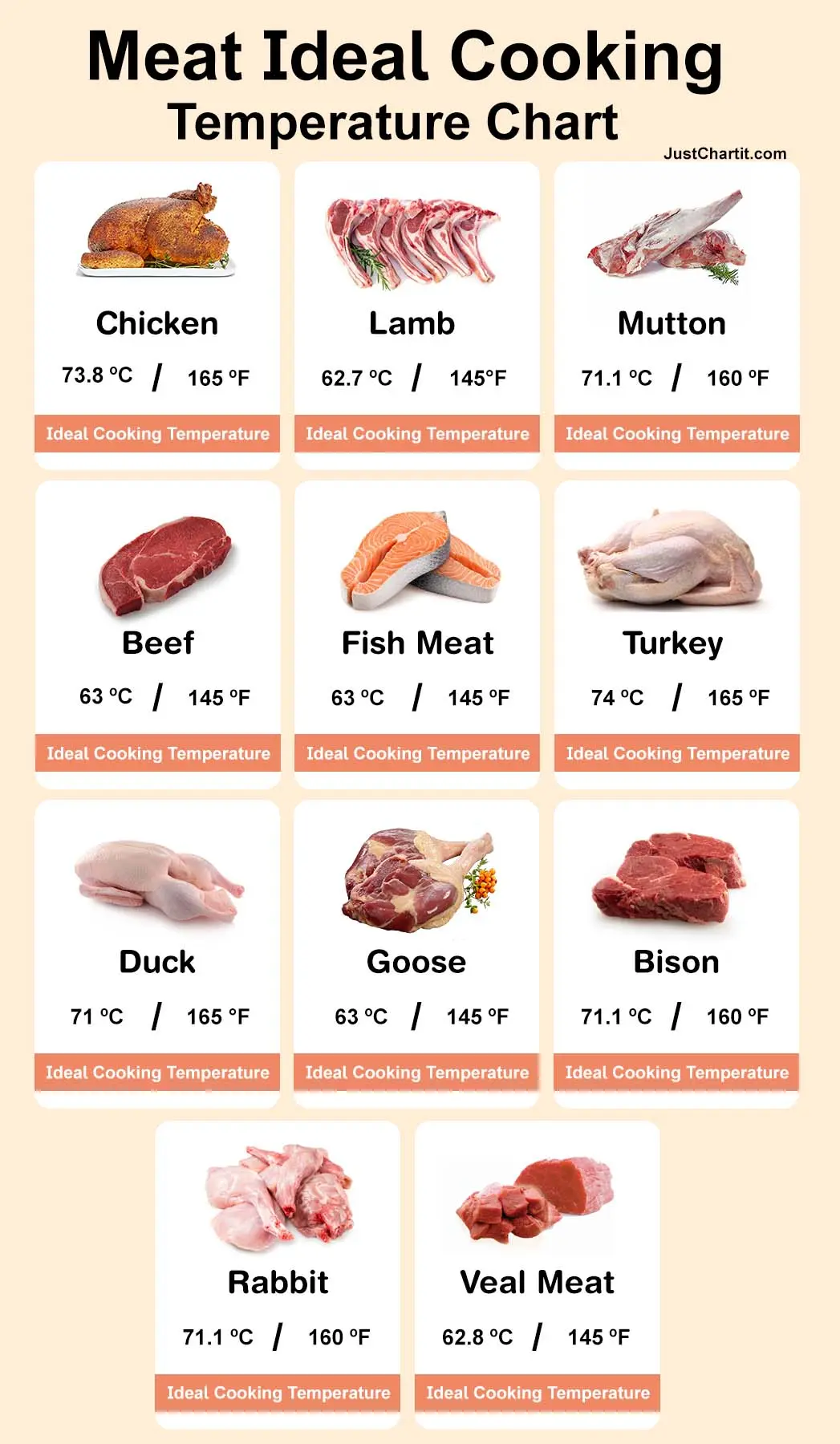Safe Food Temperatures Chart Australia The temperature range between 5 C and 60 C is known as Temperature Danger Zone This is because in this zone food poisoning bacteria can grow to unsafe levels that can make you sick The Food Safety Information Council is Australia s leading disseminator of consumer targeted food safety information and a health promotion charity
Safe temperature guide Generally potentially hazardous food must always be at 5 o C or colder or 60 o C or hotter to keep it safe You can only keep food at another temperature if you can show it stays safe at that temperature Checking the temperature Use a thermometer to check the temperature of food to make sure it s at a safe temperature Sausages Mince Poultry Rolled Roasts Liver and other offal to 75 C Reheated leftovers 75 C Fish Fillets 63 C or until flesh flakes easily Eggs and egg dishes such as quiche to 72 C or until white is firm and yolk thickens
Safe Food Temperatures Chart Australia

Safe Food Temperatures Chart Australia
https://s3.amazonaws.com/assets.cce.cornell.edu/images/2995/inline/food-temp-chart.gif?1406048129

Food Temperature Chart Pdf Our Test Kitchens Meat Temperature Chart Porn Sex Picture
https://www.justchartit.com/wp-content/uploads/2022/10/meat-temperature-chart.webp

Safe Cooking Temps Kitchen Thermometer Food Temperatures Food Safety Temperatures
https://i.pinimg.com/originals/de/b7/df/deb7df04fabfccccf3addc78309a4df8.jpg
Australia s food safety guidelines outlined by Food Standards Australia New Zealand FSANZ provide recommended minimum cooking temperatures for different types of food to ensure safety Download print and display this poster in your kitchen area to remind employees of the correct temperatures for each food type The food safety standards specify that potentially hazardous foods must be stored displayed and transported at safe temperatures and wherever possible prepared at safe temperatures However you can also use time rather than temperature to keep food safe
It shows you the exact temperature inside the food so you can be sure it s cooked all the way through Good quality and accurate thermometers cost around 15 and are available from most homeware stores To keep food safe you must minimise the time food spends in the temperature danger zone Refrigerated food needs to be kept at 5 C or below Hot food needs to be kept at 60 C or above The 2 hour 4 hour rule Studies have shown food can be safely held out of temperature control for short periods without significantly
More picture related to Safe Food Temperatures Chart Australia

Food Safe Cooking Temperature Chart Art Printable Images Gallery Category Page 84 Prin
https://i.pinimg.com/originals/79/b9/d0/79b9d0cb891b63926e4a757bbb3a50e2.png
/steas-sliced-GettyImages-622020456-5b37e7ecc9e77c001af73c3f.jpg)
Safe Food Temperatures Chart Australia Labb By AG
https://www.thespruceeats.com/thmb/kYF8hz4KB52_mh_fqWRr4xoCF8w=/3760x2115/smart/filters:no_upscale()/steas-sliced-GettyImages-622020456-5b37e7ecc9e77c001af73c3f.jpg

Safe Food Chart
https://www.mgfoodsafety.com/wp-content/uploads/2016/05/poster1-MG-1_Page_2-1.jpg
Here are suggested cooking temperatures Red meat such as beef lamb and kangaroo in whole cuts such as steaks chops pieces and whole roasts Eating these cuts of meat rare or raw may put you at risk of parasitic infection such as toxoplasmosis Leave to rest for 3 to 5 minutes When cooking food you must use reliable methods to determine that food has reached a sufficient temperature to kill bacteria Measuring the internal temperature of foods is the best method of ensuring that food has reached sufficient temperatures
Which foods do I have to keep under temperature control When must I keep food under temperature control How can my business comply with the temperature control requirements How do I measure the temperature of food What are the temperature requirements for cooling and reheating potentially hazardous food How will the requirements be enforced One crucial aspect of safe cooking is understanding and adhering to proper food safety temperatures In this guide we ll explore the significance of food safety temperatures and provide essential guidance to help you cook with confidence and keep harmful bacteria at bay

What Is The Temperature Danger Zone For Food Chart Included NBKomputer
https://www.highspeedtraining.co.uk/hub/wp-content/uploads/2020/09/The-Temperature-Zone-scaled.jpg

Temperature Control Health And Wellbeing Queensland Government
https://www.qld.gov.au/__data/assets/image/0035/166787/temperaturedangerzone.png

https://www.foodsafety.asn.au › wp-content › uploads › ...
The temperature range between 5 C and 60 C is known as Temperature Danger Zone This is because in this zone food poisoning bacteria can grow to unsafe levels that can make you sick The Food Safety Information Council is Australia s leading disseminator of consumer targeted food safety information and a health promotion charity

https://www.foodstandards.gov.au › business › food...
Safe temperature guide Generally potentially hazardous food must always be at 5 o C or colder or 60 o C or hotter to keep it safe You can only keep food at another temperature if you can show it stays safe at that temperature Checking the temperature Use a thermometer to check the temperature of food to make sure it s at a safe temperature

Safe Cooking And Reheating Temperatures Safe Cooking Cooking Food Safety

What Is The Temperature Danger Zone For Food Chart Included NBKomputer

Safe Food Temperatures Chart Australia Labb By AG

Internal Cooking Temperatures Cooking Temperatures Food Safety Tips Food Safety Training

Cooking Times And Temperatures Food Safety Temperatures Temperature Chart Food Safety

Food Safety Temperatures Sign Self Adhesive Vinyl 200mm X 300mm Food Safety Temperatures

Food Safety Temperatures Sign Self Adhesive Vinyl 200mm X 300mm Food Safety Temperatures

Food Safety Printable Food Temperature Chart

Food Safety Temperature Chart Printable

Cooking Temperatures NSW Food Authority Meat Cooking Chart Safe Cooking Cooking Guide
Safe Food Temperatures Chart Australia - When must food be kept under temperature control You must ensure that the temperature of potentially hazardous food is either at 5 C or colder or at 60 C or hotter when it is received displayed transported or stored